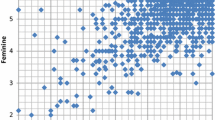Abstract
This study investigated factors important in the establishment of same-gender student-faculty role-model relationships. Subjects were 33 females and 24 male graduate students enrolled in the same academic department who responded anonymously to scales assessing four characteristics of the role model (personal attributes, life-style and values, power and influence, and professional achievement), three parallel areas of perceived similarity between student and role model (personality, attitudes and values, and professional goals), and students' self-esteem and achievement orientation. As predicted, female students rated the role-model relationship as more important to their professional development than did male students and rated the model's personal attributes and the model's life-style and values as more important in selecting a role model. Consistent with recent theoretical views, female and male students rated both the professional skills and the personal characteristics of the faculty role model as important in establishing the role-model relationship. These findings are interpreted within a framework that considers the continuing effect of belief systems about women's and men's roles on the professional development of women.
Similar content being viewed by others
References
Almquist, E. M., & Angrist, S. S. Role model influences on college women's career aspirations. Merrill-Palmer Quarterly, 1971, 17, 263–279.
Bell, A. Role models in young adulthood: Their relationship to occupational behaviors. Vocational Guidance Quarterly, 1970, 18, 280–284.
Cole, J. Fair science: Women in the scientific community. New York: Free Press, 1979.
Cole, J. R. Women in science. American Scientist, 1981, 69, 385–391.
Douvan, E. The role of models in women's professional development. Psychology of Women Quarterly, 1976, 1, 5–20.
Gilbert, L. A., Gallessich, J., & Evans, S. L. Sex of faculty role models and students' self-perceptions of competency. Sex Roles, 1983, 9, 597–608.
Goldstein, E. Effect of same-sex and cross-sex models on the subsequent academic productivity of scholars. American Psychologist, 1979, 34, 407–410.
Helmreich, R. L., & Spence, J. T. The Work and Family Orientation Questionnaire: An objective instrument to assess components of achievement motivation and attitudes toward family and career. JSAS Catalog of Selected Documents in Psychology, 1978, 8, 35 (Ms. No. 1677).
Helmreich, R., & Stapp, J. Short forms of the Texas Social Behavior Inventory, an objective measure of self-esteem. Bulletin of the Psychonomic Society, 1974, 4, 473–475.
Helmreich, R. L., Spence, J. T., Beane, W. E., Lucker, G. W., & Matthews, K. A. Making it in academic psychology: Demographic and personality correlates of attainment. Journal of Personality and Social Psychology, 1980, 39, 896–908.
Kemper, T. D. Reference groups, socialization, and achievement. American Sociological Review, 1968, 33, 31–45.
Maccoby, E. E., & Jacklin, C. N. The psychology of sex differences. Stanford, CA: Stanford University Press, 1974.
Norman, C. Sex discrimination persists in academe. Science, 1981, 214, 890.
Spence, J. T., Helmreich, R., & Deaux, K. Sex roles in contemporary American society. In G. Lindzey & E. Aronson (Eds.), Handbook of Social Psychology, 1985 (in press).
Speizer, J. J. Role models, mentors, and sponsors: The elusive concepts. Signs: Journal of Women in Culture and Society, 1981, 6, 692–712.
Tidball, M. E. Of men and research: The dominant themes in American higher education include neither teaching nor women. Journal of Higher Education, 1976, 47, 373–389.
Tidball, M. E. Perspective on academic women and affirmative action. Educational Record, 1973, 54, 130–135.
Veldman, D. J. CDC 6600 computer programs for statistical analysis. Austin, TX: Ibid, 1974.
Zuckerman, H. Scientific elite: Nobel Laureates in the United States. Glencoe, IL: Free Press, 1977.
Author information
Authors and Affiliations
Rights and permissions
About this article
Cite this article
Gilbert, L.A. Dimensions of same-gender student-faculty role-model relationships. Sex Roles 12, 111–123 (1985). https://doi.org/10.1007/BF00288041
Issue Date:
DOI: https://doi.org/10.1007/BF00288041




